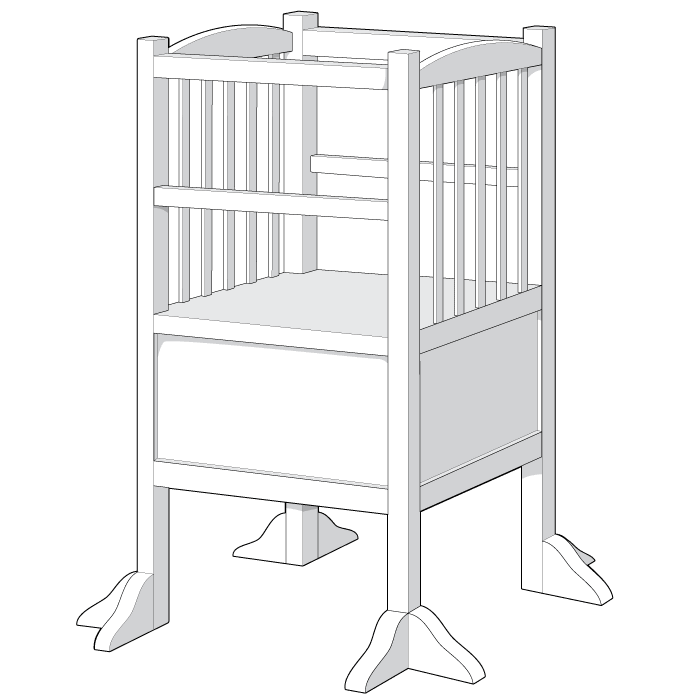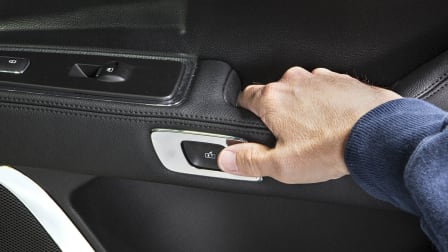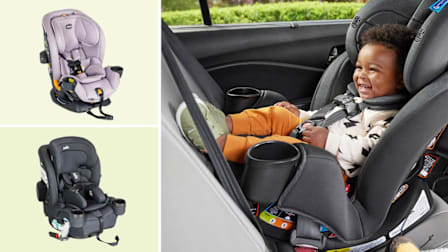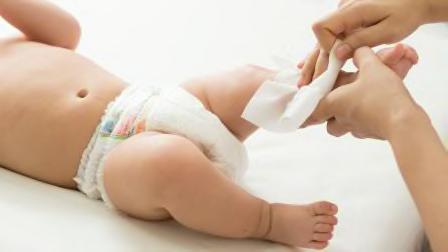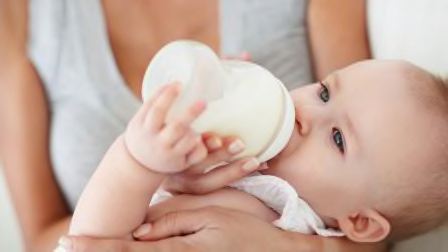Almost All the Toddler Towers We Tested Raised Safety Concerns. Here’s Why.
The better ones are heavier and have a wider, stronger base. But there are no industry standards yet.
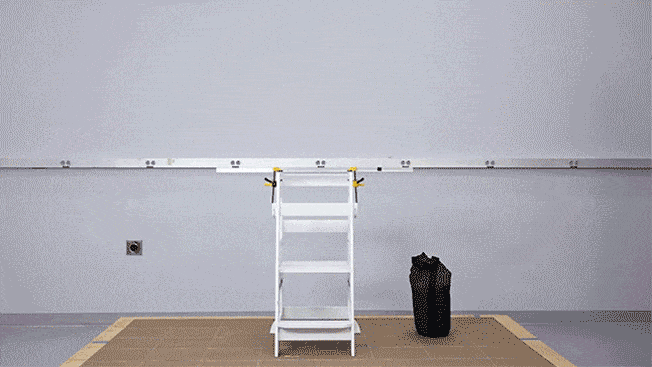
Toddler towers, which are also sometimes called learning towers, toddler kitchen stools, or helper towers, give little kids the chance to join parents or caregivers at the kitchen counter or wherever they need a boost. With guardrails and other safety features intended to keep kids from falling out, toddler towers are meant to be a safer way for them to access a high counter than, say, standing on a chair or even a step stool.
Being up high on the same level as their parents, watching and joining in everyday tasks like preparing food, can be beneficial to a child’s development, experts say. It can improve fine motor skills, encourage independence, and make little kids feel as if they’re an important part of a family’s daily routine.
“That sort of self-guided principle of learning by doing is something that a lot of educational philosophies really start with,” says Mollie Lobl, MD, a developmental pediatrician at The Children’s Hospital at Montefiore Medical Center in New York City.
Safety Issues With Toddler Towers
Sixteen safety incidents were reported to SaferProducts.gov, the CPSC’s public incident reporting database, between 2011 and 2024, most involving children 1 or 2 years of age. Fortunately, there are no known fatalities involving a toddler tower. But the reports to the CPSC describe significant falls, slips, tip-overs, split wood, loose screws, and children’s heads or limbs getting stuck in gaps between parts.
“My 2.5-year-old got his head stuck in his toddler tower between the step and the first level,” a parent wrote about a Bateso tower in 2024. That year, another person’s grandson was standing in a Cosco stool eating lunch when “he leaned slightly backward and the bar broke way and he fell backward onto the tile floor.”
In 2020, a parent wrote about a situation when their 2-year-old was at a kitchen island in an older version of the Simplay3 toddler tower. “My son was playing with his toy cars when he reached over to grab one from his left-hand side, and his weight caused the tower to tip over, allowing my son to fall onto our hardwood floors. He severely bumped his head, forcing us to rush him to the hospital.” That incident and several other reports of tip-overs caused the company to recall that version of their tower in 2023. Simplay3 offered customers a repair kit that provided a new, broader base to increase stability. The newer version passed CR’s tip-over test.
Share Your Story
Have you had a safety scare when using a toddler tower? Tell us what happened. Your story can help us push for stronger safety standards.
The Simplay3 tower is one of four recalled in recent years after multiple reports of injuries and close calls. The Step2 StepUp Sidekick was recalled in 2021 after the company discovered that the storage tray part serving as a protective barrier at the top of the tower could loosen and detach, causing a fall risk. The Onasti folding stool was recalled in March 2025 after several fall incidents, including one that caused a brain injury to a toddler.
At the end of July 2025, the Cosco Kitchen Stepper was recalled after multiple reports of children falling out of it because the “safety bar” detached or broke during everyday use. Online reviewers told stories of their children breaking an arm, splitting a lip, or getting a concussion from falling out of the Cosco stool.
Looking at the design of this stool—a two-step kitchen stool with a thin bar across the back—Gabe Knight, senior safety analyst at CR, noted the potential risks. “The so-called safety bar on the Cosco Kitchen Stepper stool gave parents a false sense of security,” she says, “but injury reports from consumers make it clear that this product should not have been advertised as suitable for use by children.”
CR corresponded with Dorel, Cosco’s parent company, about the recall, but the company didn’t respond to additional questions about CR’s own test results or answer our question about why it had marketed the stool for use by children.
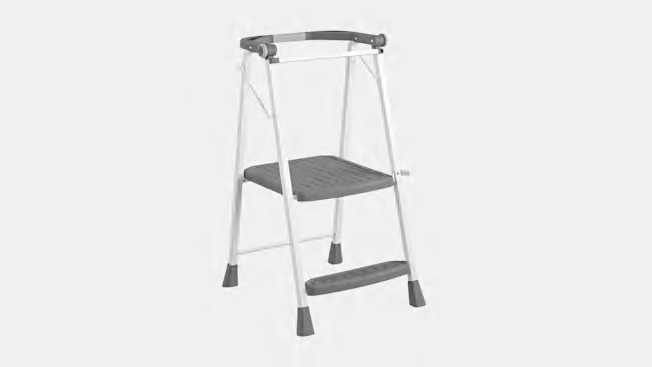
Photo: CPSC Photo: CPSC
While toddler towers have been subject to recalls, there is currently no category-specific rule or safety standard for this product type. That’s in contrast to other categories of products, such as car seats, strollers, and cribs, which have to meet federal safety standards. The result is that there’s a wide range of quality in construction and rigor in testing across the marketplace.
Experts say this is a common problem: A new product is invented, it gains popularity, then inspires scores of copycats and becomes a whole new category—all before industry or government watchdogs decide how to test or regulate the design for safety. Toddler towers are just one example. There are many more categories of children’s and baby products than one might expect that lack specific mandatory safety standards.
“If a children’s product is for sale, many parents assume it’s been tested to meet a safety standard. Unfortunately, that’s not always the case, especially for new products,” Knight says. “There is no premarket approval for products in the U.S., and it can take time for common-sense safety regulations to catch up.“
If a children’s product is for sale, many parents assume it’s been tested to meet a safety standard. Unfortunately, that’s not always the case. ... It can take time for common-sense safety regulations to catch up.
Consumer Reports’ safety experts and other advocates would like to see that change. ASTM International, an organization that brings together product experts, safety advocates, and stakeholders from industry, government, and retail to develop product safety standards, currently has a task group on toddler towers that’s working on a new voluntary standard. (CR is a member of ASTM.)
If the group votes to adopt a standard, the federal Consumer Product Safety Commission will then vote on whether or not to adopt that voluntary standard as a new mandatory rule for all companies that make or sell toddler towers. The safety regulation process is slow as it is, and recent changes to the CPSC’s leadership and structure by the Trump administration have put up new obstacles to it.
“Safety standards can take years to develop, during which time unregulated products can remain on the market,” Knight says. “Manufacturers should always incorporate safety into their product designs, regardless of whether there’s a mandatory or voluntary standard in place. Consumers expect and deserve it. Failing to test for safety not only erodes consumer trust but also can result in serious injuries, or worse.”
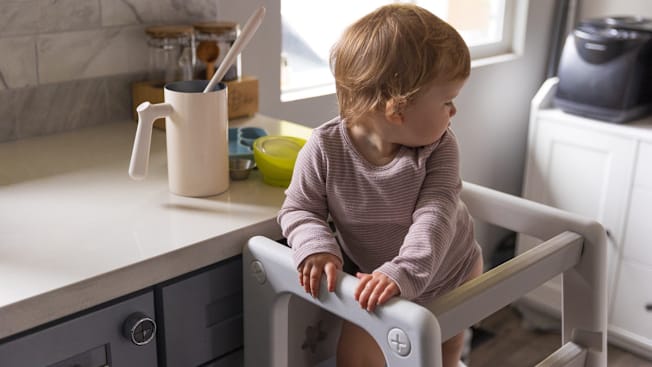
Photo: Getty Images Photo: Getty Images
Ken Waldman, president and CEO of Little Partners, is co-chair of the ASTM task group for kitchen standing towers, and says he has been pushing for safety standards for many years. Little Partners owns the trademark for the term “learning tower,” a product first invented in 1992 by a Montessori teacher. (The Little Partners Learning Tower wasn’t included in CR’s tests.)
“For about 20 years, there wasn’t a lot of competition,” Waldman says. But now, “everyone’s jumping on board, and there are a plethora of imports that don’t pass most tests and are poorly made.”
How We Tested Toddler Towers and What We Found
In the absence of any safety standard or test for toddler towers, Consumer Reports decided to conduct our own test of some of the models on the market today. Out of a huge range of products, we chose 16 popular toddler towers in a variety of design styles. We tested them for stability and entrapment risk, and then evaluated their warning label language and age recommendations. CR modeled these tests after the draft standard currently under discussion by the ASTM task force.
Stability test: This was designed to determine how well a tower resisted tipping over when weight was applied to one side, for instance, if a child leaned over to one side while standing in it or tried to climb up one side from the outside. The test technician attached a beam across the top of the tower and then hung a 35-pound weight from the beam, 6.5 inches out to the side. For the purposes of the test, the 35-pound weight simulated the weight of a 2- to 4-year-old child based on growth charts from the Centers for Disease Control and Prevention. If the tower could hold its position for 1 minute, it passed the test. If it tipped, it failed.
In all, 13 of the 16 towers failed the stability test with 35 pounds. The only three that passed were the Guidecraft Contemporary Kitchen Helper Toddler Tower, the Honey Joy Kitchen Step Stool, and the Simplay3 Toddler Tower Adjustable Stool. (The latter got a wider base after the 2023 recall.) But all of the towers that passed the 35-pound weight test failed a secondary test with a 59-pound weight. The full test results are listed in the next section, below.
Consumer Reports bought and tested 16 toddler towers. This video shows eight of the 13 towers that failed our stability test.
Ashita Kapoor, associate director of product safety at CR, who led the tests, says she initially didn’t expect that so many of the towers would fail. But when the samples arrived in the lab for testing, she changed her view.
“Once I felt how lightweight many of them were, it wasn’t a surprise that they were going to fail the stability test,” Kapoor says. “You see some manufacturers that have made a good, sturdy product, but then you see some products that are half the weight. So I think there’s definitely a variation in terms of quality.”
Entrapment test: The second test CR performed looked at the size of the gaps created by different parts of the towers and whether they could pose a danger if a child slipped or climbed through them. Ideally, any gap would be either small enough that no part of a child could pass through or large enough that their whole body could pass through it, including their head. The worst scenario would be a gap that allowed most of the body to fit through but not the head, creating a dangerous strangulation risk.
The test we performed measured how well devices called “torso probes” and “head probes” could fit through each gap we found in a tower. If both passed through, or neither passed through, the tower passed the test. If the torso passed through but the head didn’t, the tower failed.
The results showed “widespread failures in head and neck entrapment testing across most brands,” Kapoor says. Eleven towers of the 16 failed the entrapment test; only five passed.
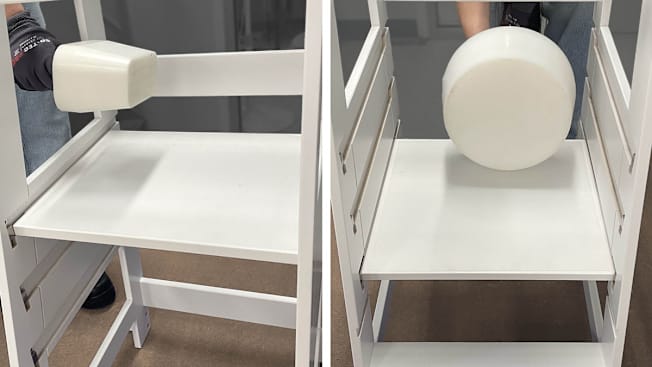
Photos: Consumer Reports Photos: Consumer Reports
Warning labels and appropriate age grading: In addition to the two dynamic tests, CR experts also looked for warning labels on the towers themselves, the packaging, and the online listings to see whether they were present and adequately expressed the risks of using the product (again, using the ASTM draft standard for comparison). CR found that five of the 16 towers lacked adequate warning labels.
Finally, age grading was a real concern. On many packages, age recommendations were either missing or inconsistent, potentially causing confusion for parents about when children could use the towers safely. The Avenlur tower, for instance, didn’t have age recommendations in its instruction manual, but the packaging said “1 year and up,” while the company’s website said 2 to 6 years. The Honey Joy tower’s instruction manual said “3 years and up,” while its Amazon listing said “3-10 years old.” Juzbot’s instruction manual and packaging said its tower was for “3 years and up,” but its Amazon listing said both “18 months and above” and “18 months to 4 years old.” (So which is it?)
CR experts say that oversights like inconsistent age grading or failing to include a maximum age could lead to children using the toddler stools when they’re too tall or heavy for the stools to fully support or enclose their bodies.
After analyzing our test results, CR’s safety experts had some recommendations for manufacturers of toddler towers.
To improve stability, they should lower the center of gravity. Companies should also consider adding four cross-feet at the base or find some other way to make the base stronger and wider to prevent tip-overs. To prevent entrapment, they should measure and test all openings to make sure that children’s torsos and heads don’t pass through at all or that both fully pass through. Companies should measure and test the openings at every adjustable height, not just one. Finally, they should prominently display warning labels that have appropriate age, height, and weight limits, including maximums.
Results: How 16 Toddler Towers Did in Our Safety Tests
FAIL
Pass
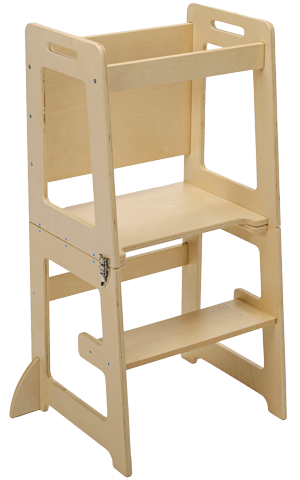
4-in-1 Foldable Kitchen Tower
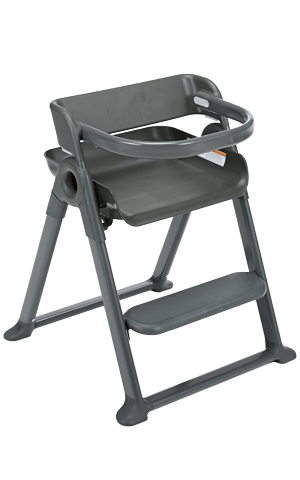
Pivot Toddler Tower
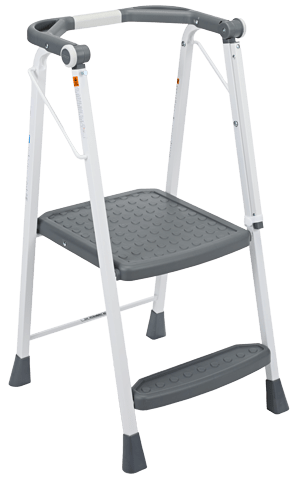
Kitchen Stepper
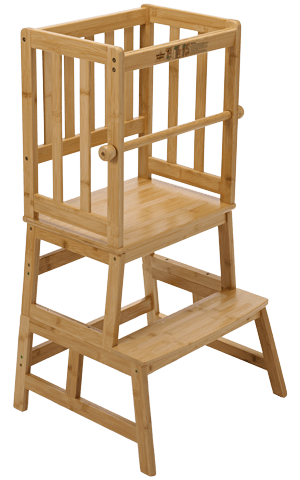
Kids Kitchen Standing Tower Step Stool Helper
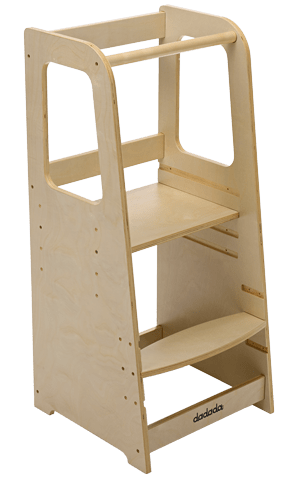
Toddler Tower
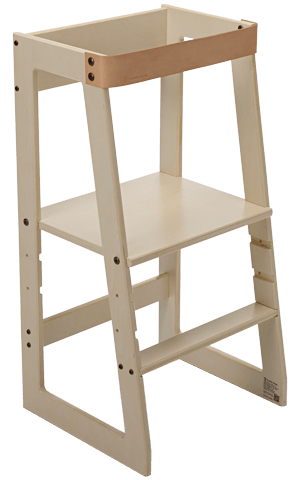
Toddler Tower
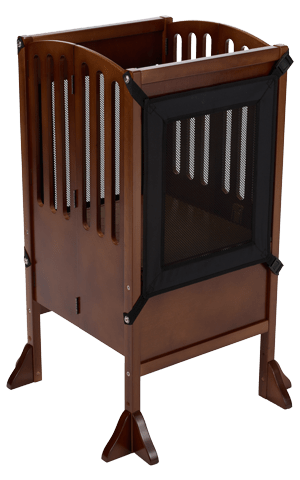
Contemporary Kitchen Helper Toddler Tower
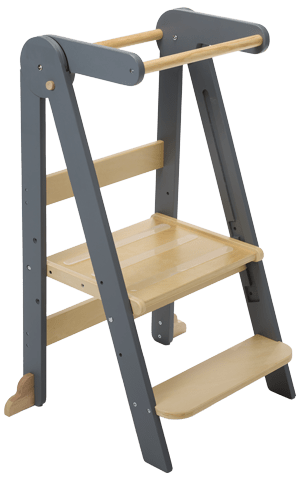
Nordi
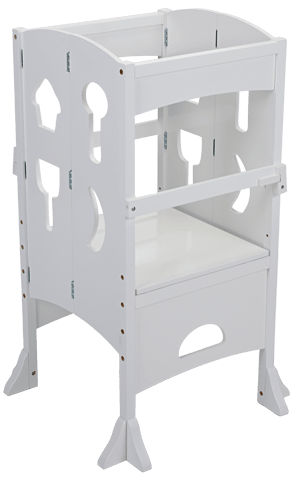
Kitchen Step Stool
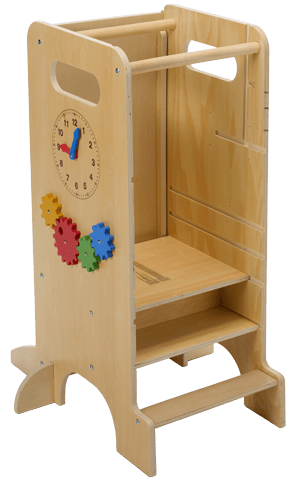
Juzbot 4 in 1 Toddler Tower
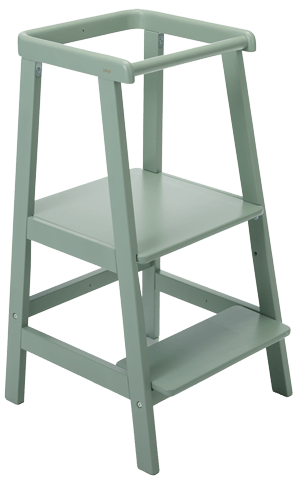
The Tower
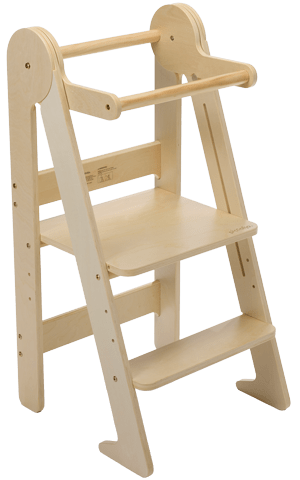
Mini Chef Foldable Helper Tower
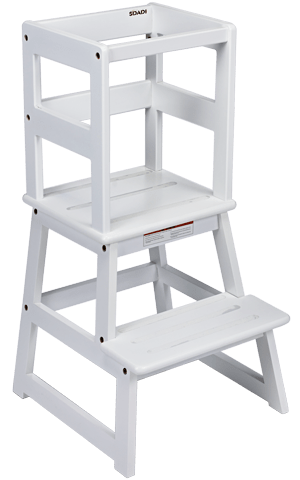
Kids Kitchen Step Stool
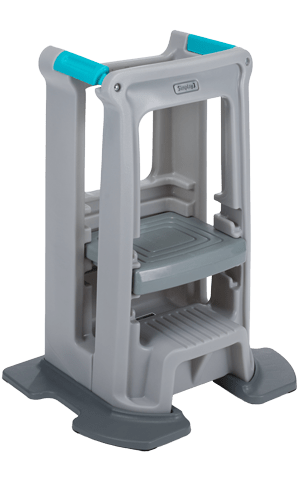
Toddler Tower Adjustable Stool
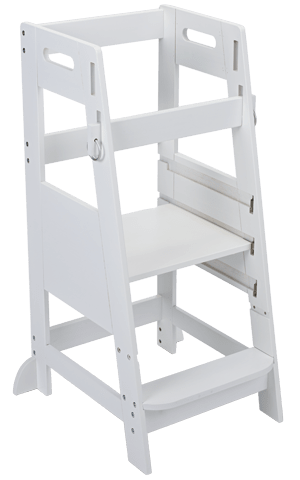
Bamboo Toddler Kitchen Step Stool
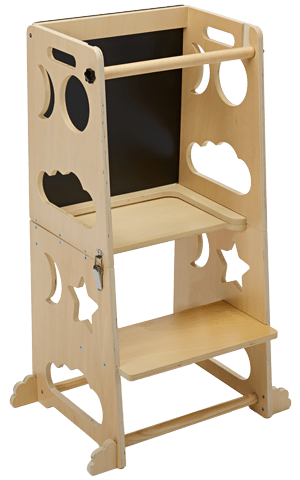
4 in 1 Convertible Toddler Kitchen Stool
Manufacturers Respond
CR reached out to the manufacturers to ask them to comment on our test results and find out how they tested their own towers before selling them. We heard back from only six of the 16 companies: Cosyland, Dadada, Guidecraft, Harppa, Lalo, and Simplay3. They all said that they had tested their towers for safety in various ways in the absence of standardized, required tests.
“We stand behind [our toddler tower’s] safety 100%,” wrote a representative from Dadada, whose tower failed both of CR’s tests for stability and entrapment. “That said, we’ve reviewed Consumer Reports’ findings thoroughly and are exploring every opportunity to make a great product even safer.”
Lalo, Harppa, and Cosyland’s towers also failed the same CR tests. Michael Wieder, Lalo’s co-founder and president, said that his company had developed its own “rigorous testing methods” and had provided feedback to ASTM’s test methodology, which is still in draft form and under discussion.
A representative from Harppa’s safety and compliance department said, “Should ASTM or CPSC issue mandatory standards in the future, we will promptly adjust our product designs to ensure compliance.” But they said the company was already working to improve the tower’s design to enhance stability and address other safety issues. The Cosyland team said the company was planning to add more brackets to future iterations of its tower’s design to improve its stability.
The Guidecraft and Simplay3 toddler towers both passed CR’s 35-pound stability test and entrapment test. Guidecraft’s president, Gary Bilezikian, said he designed its Kitchen Helper in 2009 and worked with a third-party lab and the CPSC to test it. He added that he “used standards from playpens, pack and play cribs, cribs, tables and chairs, and step stools as the basis for our product.” John Hradisky, Simplay3’s director of product development, described how the company put its tower to the test using both dummies and children in controlled environments, having the children move back and forth and “lean in the worst position possible,” for instance.
Avenlur, Boon, Cosco, Franklin + Emily, Honey Joy, Juzbot, Piccalio, Sdadi, Toetol, and Yojoker didn’t respond.
CR also asked Amazon, Target, and Walmart, where many of these towers are available, about the types of safety testing results, if any, they required of the manufacturers before selling their products. Amazon declined to comment and deferred to the manufacturers of the towers that CR tested; Target and Walmart didn’t comment.
We also contacted the industry group for children’s products, the Baby Safety Alliance (formerly known as the Juvenile Product Manufacturers Association) for comment. “While there is a draft ASTM standard in development, manufacturers should—and largely are—testing their towers for stability and functionality before sending them to market,” said Lisa Trofe, the alliance’s executive director, adding that most manufacturers are using the draft standard for reference while also adding their own tests.
Safety Tips for Parents
CR’s rest results, as well as all of the stories about child injuries, might sound a little scary. But toddler towers are really beneficial to kids and parents when they’re used safely and under supervision. If you have one at home and you supervise your toddler while they’re in it at all times, that’s a huge part of using these products safely. And if you’re shopping for a new toddler tower, here are some more tips for buying the safest one possible and keeping your little learner safe while they’re in it.
Choose your tower with safety features in mind. As a general rule, sturdiness is important. Heavier, wider towers may be less convenient to move around your house than lightweight and compact models, but they’re probably safer. Heavier towers are likely to be more stable, and they’re harder for young toddlers to move into potentially dangerous places on their own.
Check the toddler tower often for safety. Screws and fasteners can loosen over time, so you should periodically check to make sure all the pieces are securely held together. The more often your toddler tower is used, the more often you should check the fastenings for a secure fit.
Always use a toddler tower on a flat, level floor. Keep it away from windows, stairs, and the stove.
Don’t walk away. Kids can appear to be more secure in toddler towers than they would be on, say, a tall dining chair, but as CR’s tests show, tip-overs and slip-throughs are still a risk. So you’ll want to stay within arm’s length of your child to help keep them safe. Watch out for any leaning over or climbing out attempts, too.
Childproof as your child grows. Be aware of what’s now within reach of your child that wasn’t before. Check the proximity of knives, glass objects, breakable dishes, and a hot stovetop.
Consider having your kids take off their socks while they’re climbing into or standing in a tower. Shoes or bare feet are safer than slippery socks.
Pay attention to maximum age, height, and weight guidelines. Use the right gear for the right age. Toddler towers work best for children who have achieved “hands-free standing,” says Lobl of The Children’s Hospital at Montefiore. Some towers have adjustable platform heights; the guardrail at the top of the tower should be above your child’s belly button. If your child is too small for a toddler tower, use a high chair instead. If your child is too big, swap out the toddler tower for a small step stool, or don’t use anything at all.
for in a Toddler Tower
